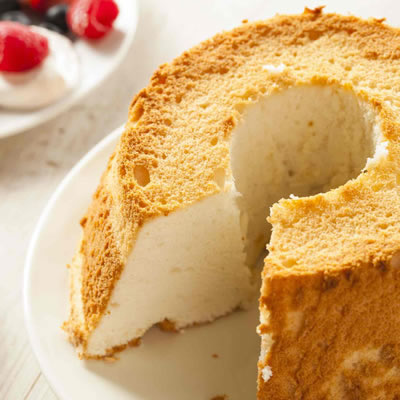Ingredient
Commonly used ingredients in angel food cake:1
| Ingredient | Type | Usage level (Baker’s percent) | Function |
|---|---|---|---|
| Egg whites | Fresh or frozen egg whites | 267 % |
|
| Sugar | White granulated sugar | 266 % |
|
| Flour | Low protein flour (Cake flour) | 100 % |
|
| Flavor | Vanilla liquid essence
Almond liquid essence |
2.5 %
1.25 % |
|
| Acid | Tartaric acid powder | 1.7 % |
|
| Salt | Granulated | 1.5 % |
|
Nutrition
Typical nutritional value of commercially available cake per 100 g:3
| Component | Grams |
|---|---|
| Carbohydrate | 58.7 |
| Water | 32.9 |
| Protein | 6.1 |
| Fat | 0.3 |
*Composition made not add to a 100 g
Angel food cake has a lower fat and calorie content than other commercial cakes, and thus represents an alternative for low calorie consumers. A commercial food cake provides 259 kcal per 100 g serving.3
Commercial production
Production process of angel food cake at home or at the bake shop:1
- Weighing and scaling the ingredients
- Whipping: egg whites are whipped until they form soft peaks Salt and cream of tartar are added at the beginning of whipping.
- Foaming: half of the sugar is added to egg whites and whipped to form a soft meringue.
- Flavoring: vanilla and other essences are added to provide flavor.
- Final mixing: flour and the rest of the sugar are added and gently folded into the mixture.
- Baking: the batter is deposited in tube baking pans, and are baked at 180 oC (360oF) for 30 min.
- Cooling
Processing considerations1
- Egg white can be slightly warmed to provide a better volume. All other ingredients should be at room temperature.
- Fresh eggs provide a better texture with a tight crumb, and thus are preferred over days old eggs.2
- Sifting flour with half of the sugar provides a better distribution in the foam.
- Avoid using steam when baking this cake.
- For chocolate angel food cake, substitute 24% of flour for cocoa.
When baking:1
| Tube Pan | Temperature | Time |
|---|---|---|
| 8 in (20 cm) | 180 oC (360oF) | 30 min |
| 10 in (25 cm) | 175 oC (350oF) | 50 min |
Regulations
Angel food cake doesn’t have a specific FDA Regulation. However, all of its ingredients are considered safe when following good manufacturing practices. A guidance for labelling of cake products establishes the correct use of the label statement.4
In the EU, this cake doesn’t have a specific regulation just like in the US. However, EU Regulation No 1169/2011 establishes the allergen information that should be disclosed to consumers.5
References
- Gisslen, W. Professional baking. No. 1. Wiley, 2019.
- Goldstein, D. The Oxford Companion to Sugar and Sweets. United Kingdom: Oxford University Press, 2015.
- U.S. Department of Agriculture, Agricultural Research Service. FoodData Central, 30 October 2020.https://fdc.nal.usda.gov/fdc-app.html#/food-details/1100890/nutrients . Accessed 12 June 2021.
- US Food and Drug Administration. “Reference amounts customarily consumed: list of products for each product category: guidance for industry.”, 2018.
- Food Standards Agency. “Food allergen labelling and information requirements under the EU Food Information for Consumers Regulation 1169/2011: Technical Guidance.” Allergen Label Tech Guide, 2015.

